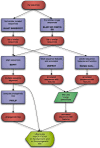The EMBRACE web service collection
- PMID: 20462862
- PMCID: PMC2896104
- DOI: 10.1093/nar/gkq297
The EMBRACE web service collection
Abstract
The EMBRACE (European Model for Bioinformatics Research and Community Education) web service collection is the culmination of a 5-year project that set out to investigate issues involved in developing and deploying web services for use in the life sciences. The project concluded that in order for web services to achieve widespread adoption, standards must be defined for the choice of web service technology, for semantically annotating both service function and the data exchanged, and a mechanism for discovering services must be provided. Building on this, the project developed: EDAM, an ontology for describing life science web services; BioXSD, a schema for exchanging data between services; and a centralized registry (http://www.embraceregistry.net) that collects together around 1000 services developed by the consortium partners. This article presents the current status of the collection and its associated recommendations and standards definitions.
Figures


References
-
- Alonso G, Casati F, Kuno H, Machiraju V. Data-Centric Systems and Applications. Berlin/Heidelberg GmBH: Springer-Verlag; 2004. Web services: concepts, architectures and applications.
-
- Wilkinson MD, Links M. BioMOBY: an open source biological web services proposal. Brief. Bionform. 2002;3:331–341. - PubMed

